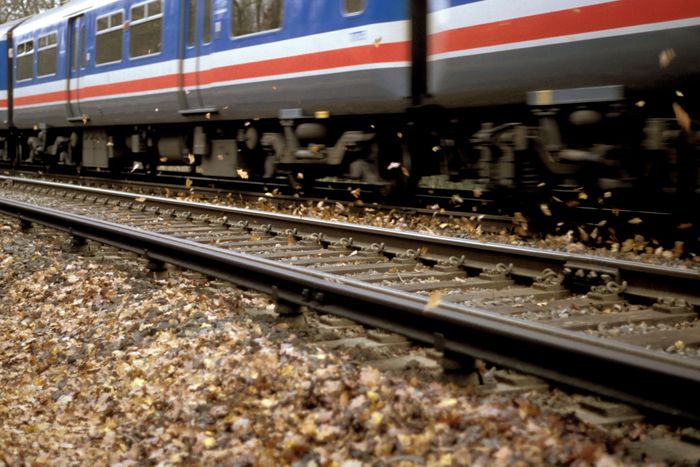
“NASA just blew up a fucking asteroid in space,” Paul Bogaards tells me, pausing every few words to emphasize his agitation. “And they can’t fix the slippery-leaves problem down here in New Jersey?” During the 20 years he spent commuting into Manhattan on New Jersey Transit’s Montclair-Boonton line, Bogaards — a longtime public-relations executive who once described his work style as “casual and profane” — came to view the rail system as a “failing state enterprise” and became something of a prolific tweeter on the topic. (“Offering $500 CASH to the commuter who comes up with the MOST ACCURATE SLOGAN for the shitshow that is @NJTRANSIT.”) The service issues on his commute were so consistently bad, he claims, that after the pandemic hit, he moved out of the state entirely: “We left New Jersey because of my experience on New Jersey Transit, to be clear.” While Bogaards’s list of complaints about the rail system is long, the delays and service issues caused by falling leaves stand out as particularly maddening, if only because a few wet leaves sound like an insignificant obstacle.
Each fall, whenever it rains and NJ Transit trains pass over wet leaves that have fallen on the tracks, the pressure of contact crushes them into a thin layer of oily residue that coats the rails, creating “slippery rail” conditions that force engineers to maneuver the trains more slowly and carefully. For commuters who rely on NJ Transit, though, the wet-leaves issue tends to register as a lazy justification for service delays. (“I understand leaves falling off of trees is a new phenomenon,” reads a typical complaint.) Throughout wet-leaf season, which typically runs from early October through December, commuters ruefully anticipate the phrase “slippery-rail conditions” being added to NJ Transit’s repertoire of excuses for delays. While the rail system has made some progress over the past two decades by acquiring millions of dollars in equipment to combat slippery-rail conditions, for riders the question remains: How is it that an issue as predictable as falling leaves can still mess with their commutes?
When I first experienced the issue for myself, en route to my dad’s birthday dinner in Morristown last October, I observed as our train inexplicably stopped for about five minutes, reversed directions, backed up behind the previous station, then started moving forward again. It proceeded to do this two more times without stopping to let anyone out. A slow-boiling social experiment began to unfold: Passengers cycled through every emotion from anger to panic; someone hit the “emergency” button, only to be informed by an NJ Transit employee that to do so in the absence of a legitimate emergency was illegal. Amid the chaos, a grizzled commuter sitting nearby, presumably in his final stage of commuter grief (acceptance), explained that the train needed a running start to gain enough momentum to get over the wet-leaf-covered hill. (NJ Transit spokesperson Jim Smith confirmed this method is deployed in “isolated instances.”)
Over the years, NJ Transit has amassed various weapons to help wage its annual war against the wet-leaf slime. Each train is equipped to spray sand on the rails in front of its wheels to increase traction, and NJ Transit employees trim nearby trees to help stem the number of leaves on the tracks. The big guns, though, are the service’s two AquaTrack machines: high-pressure power-washing systems that are mounted on flat rail cars and blast the rails with water at a rate of up to 20,000 pounds per square inch. The rail cars pull sizable water tanks, moving more slowly than passenger trains as they spray the rails, creating a cloud of mist that erupts on both sides. After implementing the first AquaTrack in 2003 on the Montclair-Boonton and Morris & Essex lines, NJ Transit expanded its coverage area in 2016 by purchasing a second one of the approximately $1 million machines, which now run twice a day in some areas. Every October, when NJ Transit fires up the AquaTracks for the first time of the season, it issues a press release that changes very little from year to year, touting the machines’ efficacy while being careful not to overpromise on anything. While the AquaTracks have reduced delays and remain what Smith calls a “critical element” in NJ Transit’s efforts to combat slippery-rail conditions, their impact isn’t always apparent to commuters.
“In general, NJ Transit seems to be caught unawares by perfectly predictable, seasonal problems — falling leaves, rain, even light snowfalls,” says Stephen Whitty, a Morris & Essex–line commuter. “I know NJ Transit never has enough money, but it seems to me that they could be a little more proactive about addressing things in advance.”
Rail systems across the Northeast have their own methods of dealing with wet leaves (the issue is prevalent anywhere with deciduous trees), but the most futuristic-sounding approach might be Long Island Rail Road’s laser train, which is leased from the Netherlands-based company Laser Precision Solutions. First used in 2019, the train comes equipped with a mechanical arm on either side that drops down to get within close range of the tracks. The mechanism then blasts the rails with a high-intensity laser to remove wet-leaf slime and other contaminated layers. While a similar technology was tested by Dutch Railways in 2014, LIRR’s laser train remains unique and was initially seen as a bit of a gamble. “No railroad wanted to try it because it’s not service-proven,” Phillip Eng, then-president of LIRR, said in 2019. “Somebody’s got to be the first to do it.” (When asked about the cost of each laser train, an MTA spokesperson declined to share any numbers.)
In the laser train’s first year of use, the MTA reported that weather-related delays for the month of November on LIRR dropped 65 percent compared to the previous year. While LIRR also uses power-washers similar to NJ Transit’s AquaTracks, the laser train is able to cover more of the system in a shorter amount of time, according to an MTA spokesperson, cleaning the rail sufficiently enough with a single pass that its effects last 24 hours. In 2020, LIRR acquired a second laser train from Laser Precision Solutions, and earlier this year, the U.K.’s Network Rail followed suit by announcing that it would be testing out its own laser train from the company. (Network Rail previously battled wet-leaf slime — or “leaves on the line,” as the Brits call it — by blasting the rails with high-pressure water jets and then depositing sand on rail heads.) When asked if NJ Transit had considered acquiring a laser train, Smith replied, “At this time, the AquaTrack units we have provide sufficient cleaning capabilities.”
Liam Blank, policy manager for the mass-transit nonprofit Tri-State Transportation Campaign, suggests that NJ Transit look into getting its own laser train but also says that adding another AquaTrack could help improve conditions as part of a multipronged strategy that would have to include more regular cleanings, especially along problem corridors. “Long story short,” he says, “it’s a solvable problem that requires a coordinated approach, and — surprise, surprise — more money.” For a transit agency without a dedicated source of state revenue and ticket sales that were still 30 percent below pre-pandemic levels for the month of September, throwing “more money” at wet leaves may not be in the cards. New Jersey governor Phil Murphy, meanwhile, is busy complaining to President Biden about New York’s congestion-pricing plan, arguing that raising tolls on New Jerseyans who commute by car would push more commuters to use the state’s overstrained, underfunded mass-transit infrastructure.
For his part, Bogaards no longer concerns himself with the politicking behind NJ Transit. He sounds entirely at peace at the end of our interview, describing the autumn leaves outside his window. As he tells it, his time away from NJ Transit has left him a changed man. “I mean, my commute now is across the lake on a ferry from the Adirondacks to Burlington,” he tells me. “And it has been two years of point-to-point travel without incident.”





